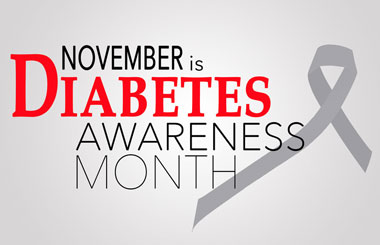
This year’s theme for American Diabetes Month is “Everyday Reality”. The American Diabetes Association (ADA) explains, “For those who’ve been diagnosed, diabetes impacts nearly every decision they make daily – from what they’ll eat, wear, do and how they’ll take care of themselves.”
According to the American Diabetes Association (ADA), a 2015 report claims that about 30 million Americans, or 9.4% of the population, had diabetes, with another 8 million undiagnosed and 84.1 million Americans age 18 and older had pre-diabetes. These alarming statistics indicate that the issue should be well discussed so that people take steps to understand and prevent diabetes. Diabetes is a chronic disease that can lead to many serious medical conditions if not managed properly. There are three types of diabetes, type 1, type 2, and gestational where Type 2 is the most common type and arises when an issue within the body leads blood glucose levels to rise higher than normal, causing the body to not use insulin properly.
However, diabetes management is often misunderstood. The goal of the American Diabetes Month campaign is to demonstrate the everyday reality of diabetes from the point of view of people living with diabetes or caring for someone with diabetes. It is important to educate people on everyday reality of diabetes. Here are some important steps that can prevent diabetes or lower a person’s diabetic level:
- Focus on healthy eating: As a WebMD report notes, the foods on your diabetes eating plan are the same healthy foods that everyone should eat. Stick to things that are low in fat, salt, and sugar, and high in fiber, like beans, fruits, vegetables, and grains. Don’t skip a meal as it can make you overeat at the next meal. Some experts recommend eating several small meals each day instead of one or two big ones.
- Exercise regularly: Regular physical activity helps the body use insulin more efficiently. Develop an exercise schedule in consultation with your doctor and follow it. Exercise can lower your blood sugar levels even a day later. Be aware of warning signs of low blood sugar, such as feeling shaky, weak, tired, hungry, lightheaded, irritable, anxious or confused.
- Manage stress: Stress can raise your blood sugar. Learn to lower stress. Strategies that can help include deep breathing, gardening, taking a walk, meditating, working on your hobby, or listening to your favorite music.
- Checkup are important: See your health care provider at least twice a year to find and treat any problems early. Follow the schedule of tests and checks recommended by your doctor.
- Know what to do: Here are some important things that a person with diabetes should do:
- Take your medicines regularly even if you feel good and make changes only if asked by your doctor.
- Consult your doctor if you find any cuts, blisters, red spots, and swelling on your feet.
- Keep your mouth, teeth, and gums healthy by brushing your teeth and flossing every day.
- Keep track of your blood sugar and keep a record of your numbers. Check with your provider as to how often and when to check your blood sugar.
- Don’t smoke.
Living with diabetes has its ups and downs, but healthy lifestyle choices can help you manage the condition, resulting in fewer health problems and improving quality of life.